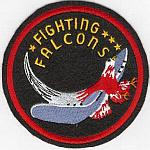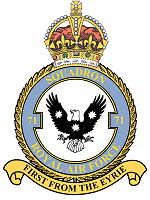The list of World War I flying aces born in Fiji contains one name thus far.
- Clive Brewster-Joske, 8 confirmed aerial victories. [1] [2] [3]
The list of World War I flying aces born in Fiji contains one name thus far.

The Curtiss P-40 Warhawk is an American single-engined, single-seat, all-metal fighter and ground-attack aircraft that first flew in 1938. The P-40 design was a modification of the previous Curtiss P-36 Hawk which reduced development time and enabled a rapid entry into production and operational service. The Warhawk was used by most Allied powers during World War II, and remained in frontline service until the end of the war. It was the third most-produced American fighter of World War II, after the P-51 and P-47; by November 1944, when production of the P-40 ceased, 13,738 had been built, all at Curtiss-Wright Corporation's main production facilities in Buffalo, New York.

The Brewster F2A Buffalo is an American fighter aircraft which saw service early in World War II. Designed and built by the Brewster Aeronautical Corporation, it was one of the first U.S. monoplanes with an arrestor hook and other modifications for aircraft carriers. The Buffalo won a competition against the Grumman F4F Wildcat in 1939 to become the U.S. Navy's first monoplane fighter aircraft. Although superior to the Grumman F3F biplane it replaced, and the early F4Fs, the Buffalo was largely obsolete when the United States entered the war, being unstable and overweight, especially when compared to the Japanese Mitsubishi A6M Zero.

A flying ace, fighter ace or air ace is a military aviator credited with shooting down five or more enemy aircraft during aerial combat. The exact number of aerial victories required to officially qualify as an ace is varied, but is usually considered to be five or more.

The Grumman F4F Wildcat is an American carrier-based fighter aircraft that entered service in 1940 with the United States Navy, and the British Royal Navy where it was initially known as the Martlet. First used by the British in the North Atlantic, the Wildcat was the only effective fighter available to the United States Navy and Marine Corps in the Pacific Theater during the early part of the Second World War. The disappointing Brewster Buffalo was withdrawn in favor of the Wildcat and replaced as aircraft became available.

No. 488 Squadron was the name given to two distinct Royal New Zealand Air Force squadrons during the Second World War. Both were formed under Article XV of the Empire Air Training Scheme and served under the operational command of the Royal Air Force.

Eino Ilmari "Illu" Juutilainen was a fighter pilot of the Ilmavoimat, and the top scoring non-German fighter pilot of all time. The top flying ace of the Finnish Air Force, he led all Finnish pilots in score against Soviet aircraft in World War II, with 94 confirmed aerial combat victories in 437 sorties. He achieved 34 of his victories while flying the Brewster Buffalo fighter.

Geoffrey Bryson Fisken, was a New Zealand fighter pilot who was the British Commonwealth's leading air ace in the Pacific theatre of World War II. He is credited with shooting down 11 Japanese aircraft.

Marine Fighting Squadron 221 (VMF-221) was a reserve fighter squadron of the United States Marine Corps. Originally commissioned during the World War II, it flew the Brewster F2A-3, and after reconstitution in 1943, the F4U Corsair. The squadron, also known as the “Fighting Falcons”, is most notable for its actions on June 4, 1942, during the Battle of Midway, which resulted in 23 members of the squadron, many posthumously, being awarded the Navy Cross for their actions in combat. VMF-221 ended World War II with 185 air-to-air victories, the second most of any Marine Fighting Squadron in the war.

No. 71 Squadron was a Royal Air Force aircraft squadron. The number has been used three times: once by the Royal Flying Corps for an Australian Flying Corps squadron; in the Second World War as the first of three Eagle Squadrons; and post-war as a fighter-bomber unit under the command of Royal Air Force Germany.

Lauri Olavi Pekuri was a Finnish Air Force ace and jet aircraft pioneer. In 1942, Pekuri changed his name from Ohukainen. This older name can still be found in aviation literature.

No. 24 Squadron, renamed No. 24 Fighter Squadron was a fighter squadron of the Finnish Air Force during World War II. The squadron was part of Flying Regiment 2.

No. 112 Squadron was a squadron of the Royal Air Force. It served in both the First World War and Second World War and was active for three periods during the Cold War. It is nicknamed "The Shark Squadron", an allusion to the fact that it was the first unit from any Allied air force to use the famous "shark mouth" logo on Curtiss P-40s.

Joske's Thumb is a precipitous volcanic plug that rises in the skyline to the west of Suva, Fiji. It is located 15 kilometers west of Suva and its base is accessible from Naikorokoro Road, which connects Naikorokoro Village to Queens Road. Other sources note that Naikorokoro Road, the road toward Joske's Thumb, intersects on the north side of Queens Road, 0.8 kilometres west of the Lami Bay Hotel outside Lami.
No. 243 Squadron was a flying squadron of the Royal Air Force. Originally formed in August 1918 from two flights that had been part of the Royal Naval Air Service, the squadron conducted anti-submarine patrols during the final stages of World War I. The squadron was later re-raised during World War II, operating initially as a fighter squadron in Malaya and Singapore during 1941–42. It was briefly disbanded just prior to the fall of Singapore, and was re-formed in mid-1942, again as a fighter squadron, and fought in the Tunisian and Italian campaigns in 1942–44, before being disbanded in October 1944. In 1945, after training on transport aircraft in Canada, the squadron moved to Australia where it operated in support of the British Pacific Fleet before disbanding in mid-1946.

Jorma "Joppe" Karhunen was a Finnish Air Force ace and an author.

Peter Jeffrey, was a senior officer and fighter ace in the Royal Australian Air Force (RAAF). Born in Tenterfield, New South Wales, he joined the RAAF active reserve in 1934, and transferred to the Permanent Air Force (PAF) shortly before World War II. Posted to the Middle East in July 1940, Jeffrey saw action with No. 3 Squadron and took command of the unit the following year, earning the Distinguished Flying Cross for his energy and fighting skills. He was appointed wing leader of No. 234 Wing RAF in November 1941, and became an ace the same month with his fifth solo victory. The next month he was awarded the Distinguished Service Order for his achievements, which included rescuing a fellow pilot who had crash landed in the desert.

Group Captain Clive Alexander Brewster-Joske, later known as Clive Brewster, was a Fiji-born British subject of Australian heritage. He became a flying ace during World War I and was credited with eight aerial victories. Upon his return to civil life post-war, he became a leading citizen of Fiji being entrusted by several foreign governments as their consular agent. He returned to service at the beginning of World War II, rising first to the rank of lieutenant colonel, then to that of group captain.